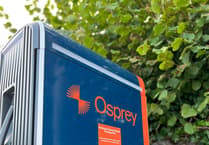Pembroke Dock, 8.40am on Tuesday, January 16 and the heron has returned to the centre of the town.
The heron - let’s assume it’s the same one - was first spotted in the vicinity of Park Lane last Thursday when it paced the corrugated roof of a garage, perhaps enticed by the presence of a pond in the neighbouring garden. It was an icy morning, so the visit probably met with disappointment.
This time, sat on the rooftop, the noble bird soon found its vigil, and dignity, under attack from seagulls. The heron was forced to duck his head many times as the gulls circled and swooped. The fish-eating wader stood its ground during the assault, but it knew where it wasn't welcome, and departed soon after the incident.
According to the Wildlife Trust, “these tall birds spend most of their time alone feeding mainly on fish but can be tempted by the occasional tasty mole! When feeling particularly lazy the heron will visit gardens with ponds for a quick and easy snack.”
Herons are more often seen during winter, with the RSPB recording 63,000 birds wintering in the UK.
Herons are adaptable birds and will feed in any water, whether fresh, salt, clear or muddy, as long as it yields a catch. In winter, many grey herons utilise built-up areas.
Good places to spot a grey heron locally are Bosherston Lily Ponds, Carew, Pembroke Millpond and Neyland Pill Nature Reserve. The heron can sometimes be found in the water at Pembroke Dock, off Cleddau Reach or Western Way, which is frequently home to its pure white cousin the egret.
The Dairy Diary adds: “In the countryside, herons are timid but in towns and cities they are amazingly unperturbed by all the hustle and bustle.”
Once again, we apologise for the judder on the video footage, which is the result of using a heavy camera on full zoom.



